This Baked Lemon Pepper Salmon recipe is one of the easiest AND most flavorful recipes you’ll sink your teeth into with a prep time of less than 15 minutes!
This Lemon Pepper Salmon will have everyone swooning and is SO easy to make – on your table in 30 minutes! The vibrant salmon is extravagantly juicy, tender and dripping with bold, bright, zesty, garlic, lemon pepper butter deliciousness. This speedy recipe boasts hardly any cleanup and is prep ahead friendly, making it perfect for easy weeknight dinners or fabulous for special occasions (hello Mother’s Day) or entertaining. This baked Lemon Pepper Salmon comes with a side of asparagus but feel free to add Hasselback potatoes, rice pilaf, fruit salad or strawberry spinach salad for a complete feast!
Salmon is always a quick and easy dinner win! If you’re looking for more baked salmon recipes, be sure to check out our favorite cilantro lime salmon, Cajun honey mustard salmon in foil, baked panko garlic butter salmon, baked teriyaki salmon, baked Greek salmon, and baked fajita salmon.
PIN THIS RECIPE TO SAVE FOR LATER
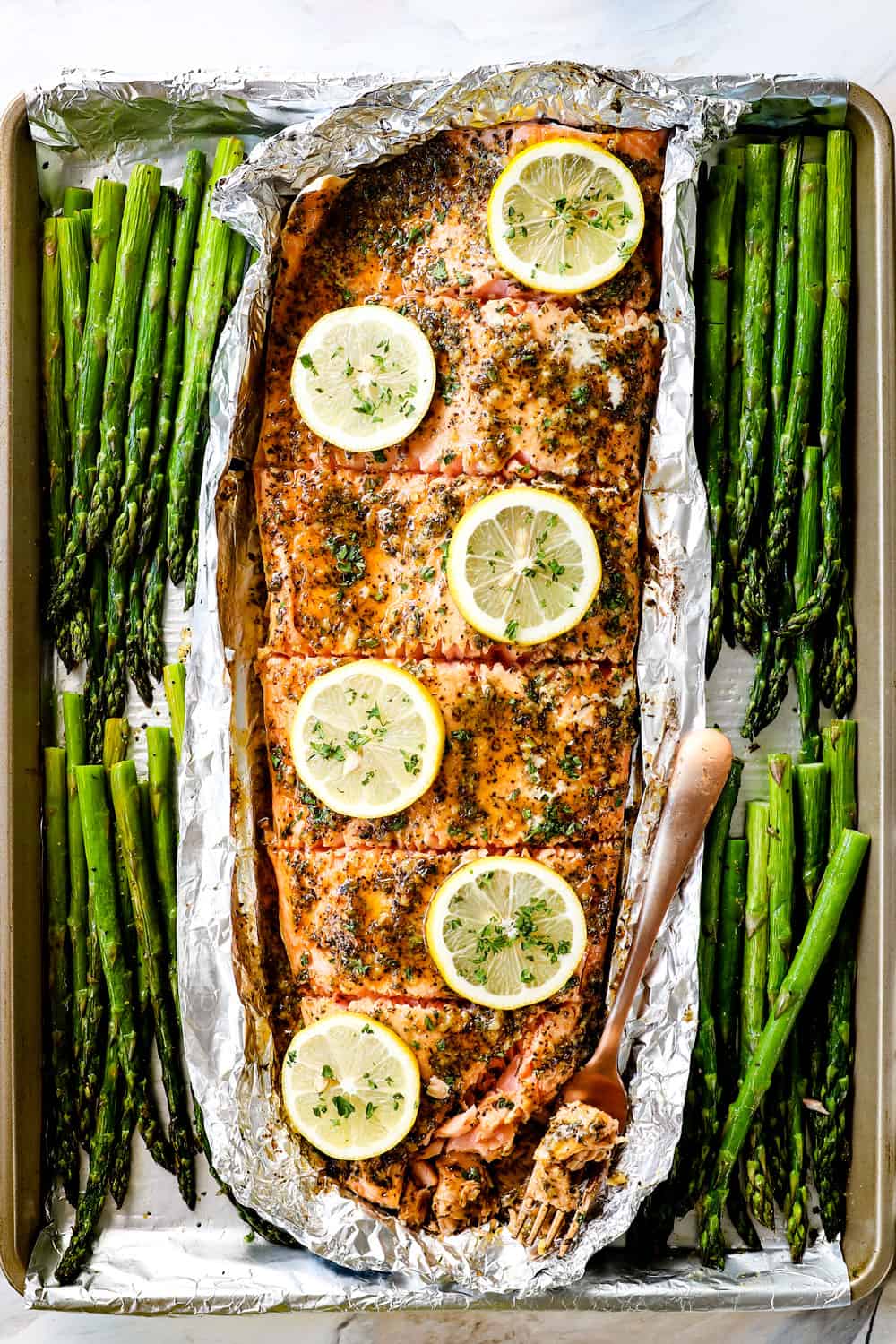
HOW TO MAKE BAKED lemon pepper SALMON VIDEO
5 reasons to love this lemon pepper salmon RECIPE:
- This Lemon Pepper Salmon is boldly flavorful – you will be blown away at the vibrant flavors dripping from every bite! The salmon is seeping with full-flavored bright, zesty, lemon, pepper garlic notes laced with paprika, thyme, parsley, basil and dill.
- This recipe takes minutes of hands-on prep. Whisk together the magical lemon pepper garlic butter, slather it over the salmon then pop it in the oven for hand’s off baking – that’s it! The butter literally does all the work!
- Baking salmon is foolproof. Baking salmon doesn’t require any babysitting and produces the most evenly cooked, juicy, silky, succulent, buttery tender salmon every time – all cooked at once!
- The recipe is baked with asparagus. Lemon butter salmon and asparagus are a match made in heaven and baking them in the same pan at the same time means less work for you!
- The Lemon Pepper Salmon is prep ahead friendly. Whisk the lemon pepper butter together, line the salmon on a baking sheet and refrigerate. At dinner time, just combine and pop it in the oven for a stress-free win!
how do i choose salmon?
Salmon is my favorite fish to bake because it’s mild, un-fishy, rich and buttery and the perfect canvas for the lemon pepper butter. Salmon is also rich in protein and exceptionally good source of omega-3 fatty acids, magnesium and selenium and B vitamins, particularly B6 and niacin. So, what should you look for when selecting salmon? Here are a few tips and tricks:
- Use wild caught salmon if possible. To make the best Lemon Pepper Salmon, start by selecting the best salmon available. Look for salmon that is bright pink in color, smells fresh but not fishy, and, if possible, is wild caught. I prefer wild caught salmon (king, coho and sockeye) because it has richer flavor, but if you want milder flavor, than farm-raised Atlantic salmon might be the way to go. Atlantic salmon can cook up watery or mushy due to the artificial diet but I have had success with farm raised salmon from Costco (fresh and frozen), they seem to have higher quality suppliers.
- What size salmon is best? You can use either six or seven 6-8 oz. salmon fillets OR one 2 1/2-3-pound salmon fillet.
- Where to purchase salmon? Purchase salmon at the seafood counter of your local market or grocery store to ensure the freshest salmon. Costco also has a good selection of fresh and frozen salmon.
- Can I use frozen salmon? Absolutely! Frozen fish is a great option because it is packaged at peak freshness in individual fillets so you can use just what you need. It’s also easy keep stocked. Costco has excellent frozen salmon (am I sounding like a Costco commercial yet 😆). To thaw, either transfer the packaged fillets (or place in a sealable bag) from the freezer to the refrigerator to sit overnight (it can 12 to 24 hours to thaw) or let the salmon (packaged) rest in a large bowl of cold water for 30-60 minutes, changing the water occasionally if it’s gone tepid.
- Do I use skin on or off salmon? Your large salmon fillet will likely come with the skin on. You should cook salmon with the skin on and then it will easily peel off after cooking. Cooking salmon with the skin on traps in moisture and prevents juices from running out the bottom of the salmon, keeping it extra juicy. If you purchase skinless salmon fillets, they will still be delicious.
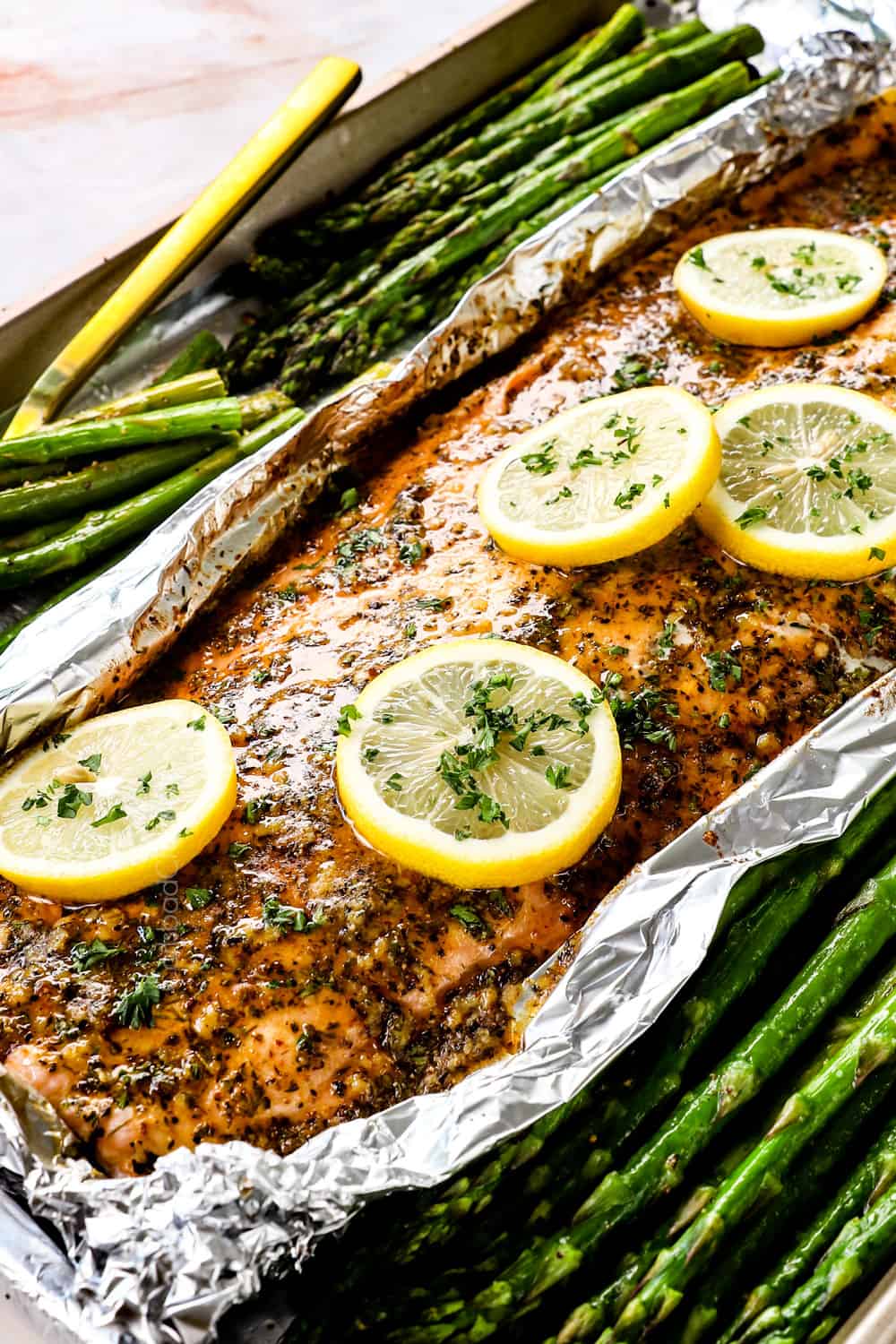
Can I Use Other Types of Fish?
Absolutely! The bold, lemon pepper, garlic flavors in this recipe would be a welcome addition to any of your favorite types of fish. Give these a try:
- Mahi Mahi
- Halibut
- Haddock
- Trout
- Tilapia
- Cod
- Grouper
- Rockfish
- Sole
baked salmon recipe Ingredients
This Lemon Pepper Salmon is bright, peppery, buttery, sunshine perfection made with just a few ingredients. In addition to the salmon, you will need (find full recipe measurements in the recipe card at the bottom of the post):
- Lemon pepper seasoning: This seasoning is a lemon lovers dream made with dehydrated lemon zest, black pepper, salt, garlic powder, and onion powder. It delivers a bold punch of lemon pepper goodness that elevates this recipe to extraordinary.
- Butter: Salmon and butter are a match made in heaven! Butter adds that rich, buttery flavor we all love and keeps the salmon extra moist. Use unsalted butter otherwise reduce the salt in the recipe or the salmon will be too salty. If you’re looking for a healthier alternative, you can replace some or all of the butter with extra virgin olive oil.
- Lemon juice: Most of the lemon flavor will come from the lemon pepper seasoning but the lemon juice adds a splash of freshness.
- Garlic: Fresh garlic adds that punch of garlicky goodness. Fresh is best but you may substitute with 1 teaspoon garlic powder if needed.
- Dijon: I promise Dijon won’t make your baked salmon recipe tasty mustardy! Instead, it underscores the lemon juice in all the right ways with additional complex, tangy depth. If you’re strongly opposed, you can skip it.
- Seasonings: The recipe is rounded out with fresh or dried parsley, thyme, basil, paprika, dill, onion powder and salt – no one note baked salmon here!
- Asparagus: The asparagus is optional but makes a fabulously easy, tasty side. Look for medium asparagus so it bakes in the allotted time. If you can only find super thin asparagus, add it after the salmon has been baking a few minutes.
IS THIS SALMON RECIPE GLUTEN FREE?
Yes, this oven baked salmon is gluten free but you’ll want to double check the label of your lemon pepper seasoning.
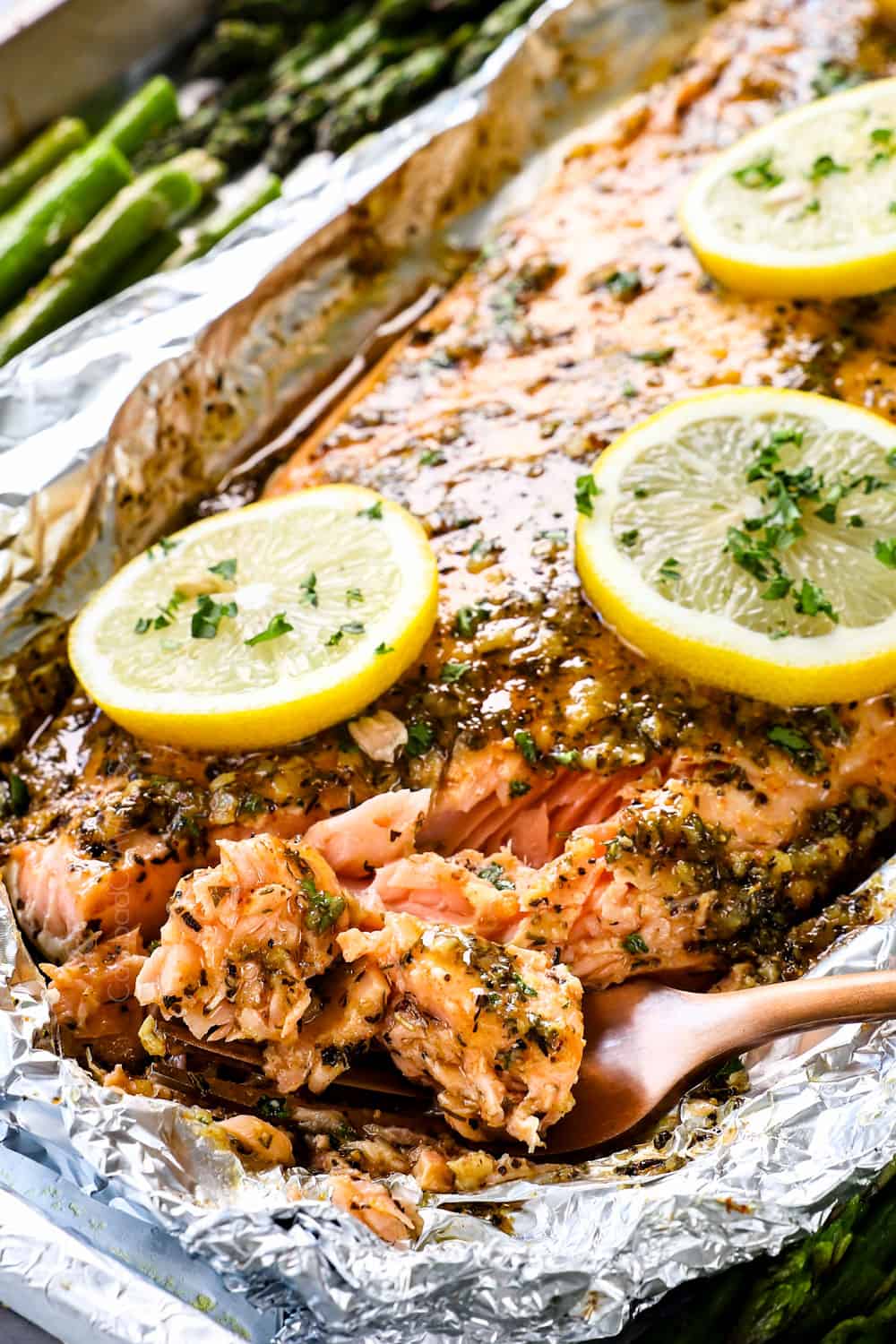
WHAT IS LEMON PEPPER SEASONING MADE OF?
Lemon Pepper is the defining flavor and ingredient in this Lemon Pepper Salmon recipe. Lemon pepper is a delightful flavor bomb of bright and tangy lemon with feisty pepper. It is made by mashing dehydrated granulated lemon zest with cracked black peppercorns to infuse the pepper with the citrus oil.
I love lemon pepper because it delivers dynamic lemon flavor in minutes and the pepper pumps of the flavor. Anything you smother in lemon pepper seasoning is guaranteed to have flavor – and this baked salmon recipe is no exception!
WHERE CAN I BUY LEMON PEPPER SEASONING?
Lemon Pepper Seasoning is very common which is good news for us! You should easily be able to find it in the spices section of your grocery store. Purchase it for this recipe then use it on chicken, shrimp, vegetables and more!
Can I make homemade lemon pepper seasoning?
Absolutely! Store-bought lemon pepper seasoning is super convenient but you are welcome to make your own by dehydrating lemon zest in the oven for a few hours and then combining in your blender with peppercorns and sea salt like in this recipe.
HOW TO MAKE lemon pepper SALMON
Are you ready to see just how easy this Lemon Pepper Salmon recipe is to make? Let’s take a closer look with step-by-step photos (full measurements in the recipe card at the bottom of the post):
- Step 1: Prep asparagus (optional). If using asparagus, add them to a foil lined baking sheet and toss with olive oil, salt and lemon pepper. Line them on each side of the pan, leaving a space for the salmon down the middle; don’t worry that the asparagus is overlapping.
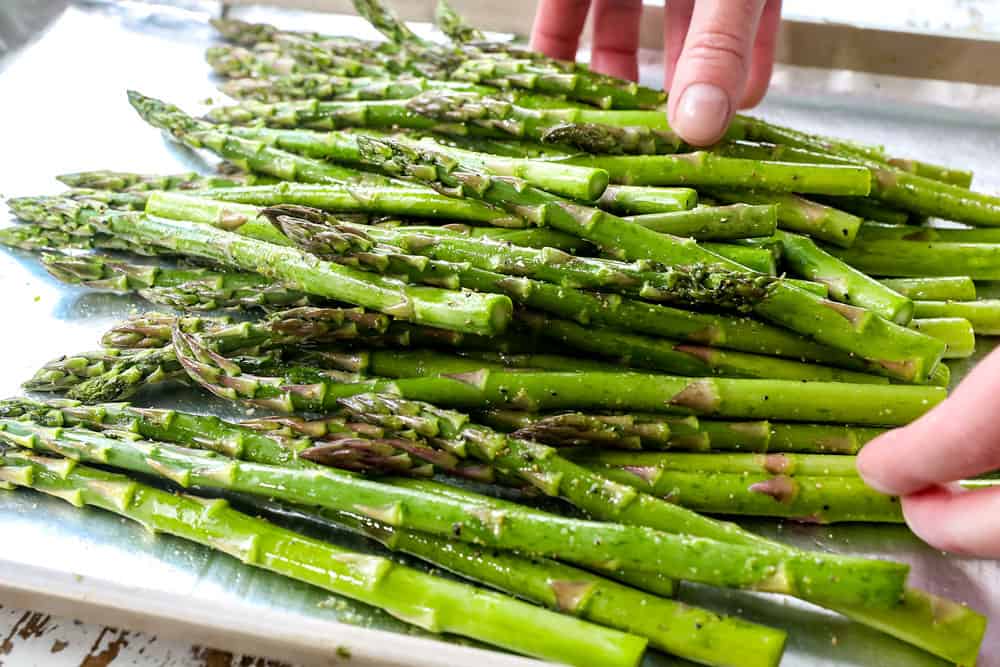
- Step 2: Prep salmon. Add salmon skin side down (if it has it) to a large piece of foil and fold the foil up around salmon to create a boat. This will keep all of the lemon pepper butter goodness from melting away from the salmon.

- Step 3: Make lemon pepper butter. Add the butter and minced garlic cloves to a medium bowl and microwave until butter is melted. Whisk in the lemon juice, Dijon and all seasonings.
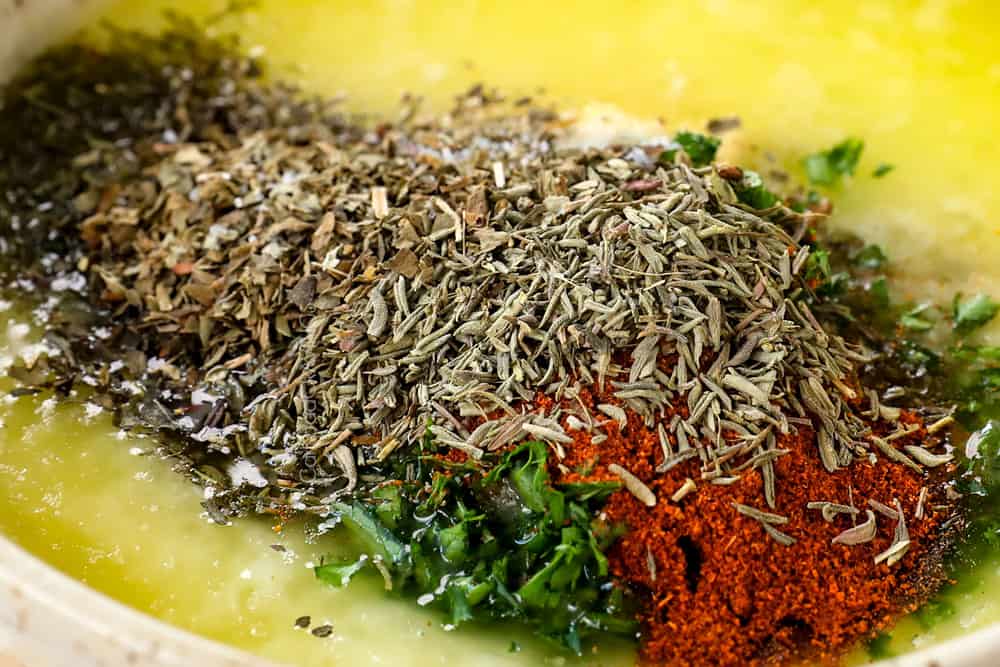
- Step 4: Add lemon pepper butter. Pour the butter evenly all over salmon.

- Step 5: Bake. Bake for 12-17 minutes or until salmon is almost opaque throughout (internal temp of 125-130 degrees F) and easily flakes with a fork.
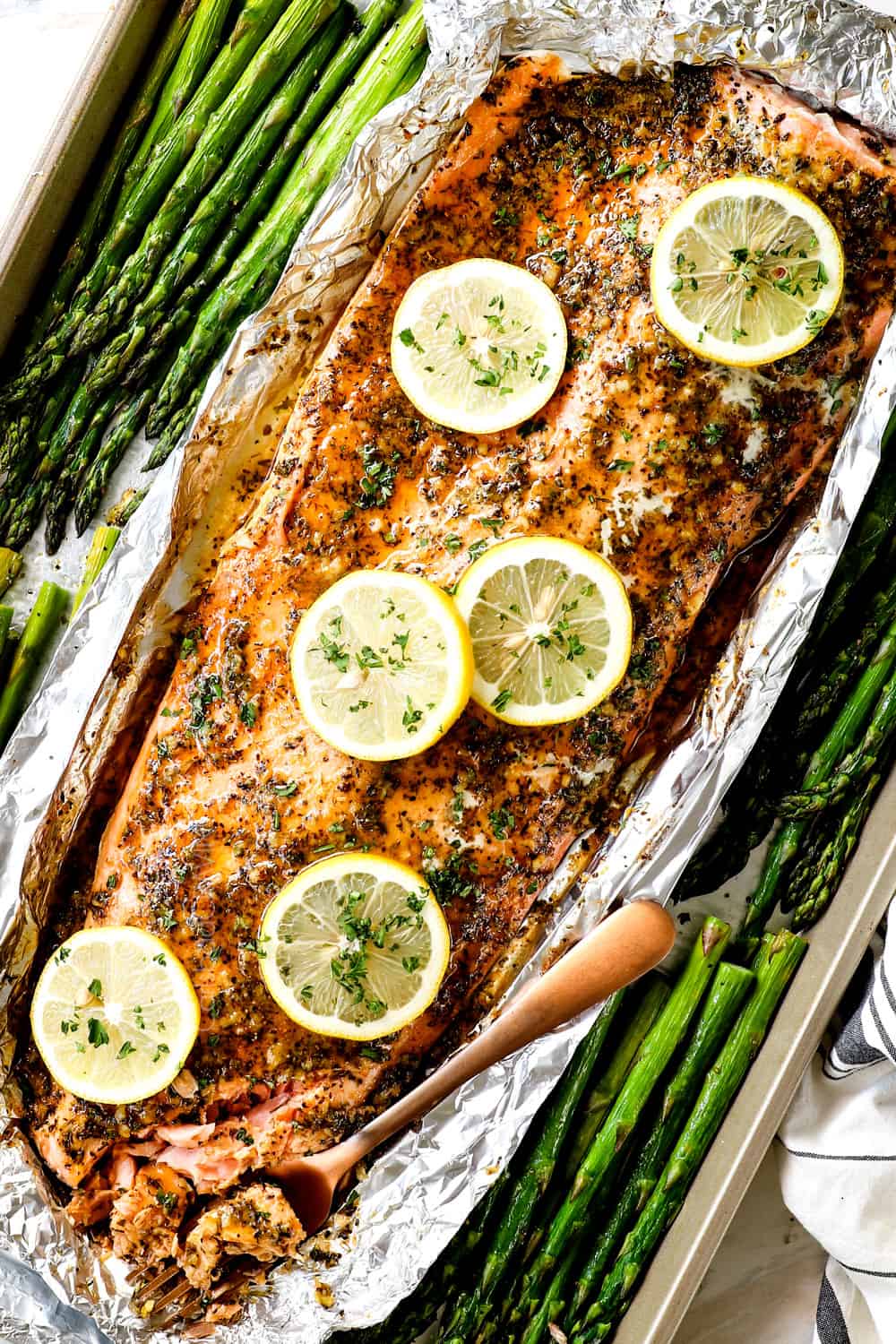
WHAT TEMPERATURE TO BAKE SALMON?
America’s Test kitchen suggests baking your salmon until it reaches 125-130 degrees F (52 degrees C) to avoid overcooked salmon. 125-140 degrees will be medium to medium-well. I like to cook mine to 130 degrees F and the results are always perfect after a 5-minute rest. During the 5-minute rest, the salmon will continue to cook (carryover) and rise about 5 degrees. Always take this carry over into consideration when taking the temperature of your salmon or any protein.
Note: The FDA advises salmon should be cooked to an internal temperature of 145 degrees Fahrenheit, HOWEVER, if you cook your salmon to this temperature, it will be dry, chalky and overdone.
HOW can you tell WHEN SALMON IS DONE?
The most accurate way to tell if your salmon is done is with an instant read meat thermometer, but if you don’t own one, you can also pay attention to appearance. As salmon cooks, it changes from bright pink (raw) to opaque pink. The outside of the salmon should be completely opaque but the center should still be a bit translucent, a moist coral color, but not raw. If the salmon is completely opaque all the way through, it won’t be as juicy and tender.
Cooked salmon will also easily flake with a fork along the muscle fibers. Take care not to overcook your salmon because it will only remain buttery, juicy and tender as long as it isn’t overcooked. It is better for salmon to be under-cooked than overcooked in my opinion.
TIPS FOR THE BEST BAKED SALMON RECIPE
This baked Lemon Pepper Salmon is very simple to make, but here are some tips and tricks to make it the best salmon every time:
- Purchase quality salmon. Refer to the section on how to purchase salmon above. Cooking Light also has a great article on how to pick the best salmon at the grocery store.
- Use salmon right away. If you’re using fresh salmon, make sure to use it within one day otherwise it can go bad very quickly.
- Do NOT rinse salmon before baking. The USDA cautions: “Do not rinse raw fish, seafood, meat, and poultry. Bacteria in these raw juices can splash and spread to other foods and surfaces. Cooking foods thoroughly will kill harmful bacteria.”
- Let salmon come to room temperature. Salmon should never be baked cold straight from the refrigerator otherwise it will cook unevenly. Place the salmon on the counter 30 minutes before you’re ready to bake it. You can slather it in the lemon pepper butter during this time.
- Slice salmon if needed to fit. If your salmon won’t fit on the pan, slice it into 2-inch pieces then line the pieces next to each other in rows within the foil “boat.” You can place all of the salmon at the top of the pan and the asparagus at the bottom if that fits better.
- Don’t over-cook the salmon. Take care not to overbake the salmon because it will only remain buttery, juicy and tender as long as it isn’t overcooked. Aim for 125-130 F degrees and allow it to rest for 5 minutes before serving. If you have different size salmon fillets, you may need to remove one fillet from the oven before the rest are done.
- Use a meat thermometer. Overcooked salmon is dry salmon. The only way to ensure perfectly cooked salmon is to use a meat thermometer. You can pick up an inexpensive instant read thermometer at the grocery store or Amazon, or I am obsessed with this digital probe thermometer – you will never overcook any protein again! Instant read thermometers can be temperamental, but this digital probe thermometer retrieves temperature precisely to within ±1.8°f (±1°c) and allows you to insert a probe into two pieces of fish/protein at a time (I suggest the thinnest and thickest).
- Let the salmon rest. After your baked salmon is finished cooking, transfer it to a plate and let it rest for 5 minutes before serving. While the salmon cooks, the juices are forced away from the heat to the middle of the fish. The resting time allows for the redistribution and reabsorption of the juices throughout the whole fillet for optimal flavor and juiciness. If you don’t allow for this calming period, valuable moisture-giving juices will seep out and be lost when you bite into the salmon, resulting in less juicy fish.
- To quickly trim asparagus: The ends of asparagus are chewy and woody. To quickly eliminate the ends, hold one piece of asparagus and bend it until it snaps in two. The asparagus will naturally snap where the tough end begins. Instead of breaking the ends off of every individual piece of asparagus, I save time by snapping one asparagus, then line the rest up of the asparagus up and chop off all the ends at this same point.
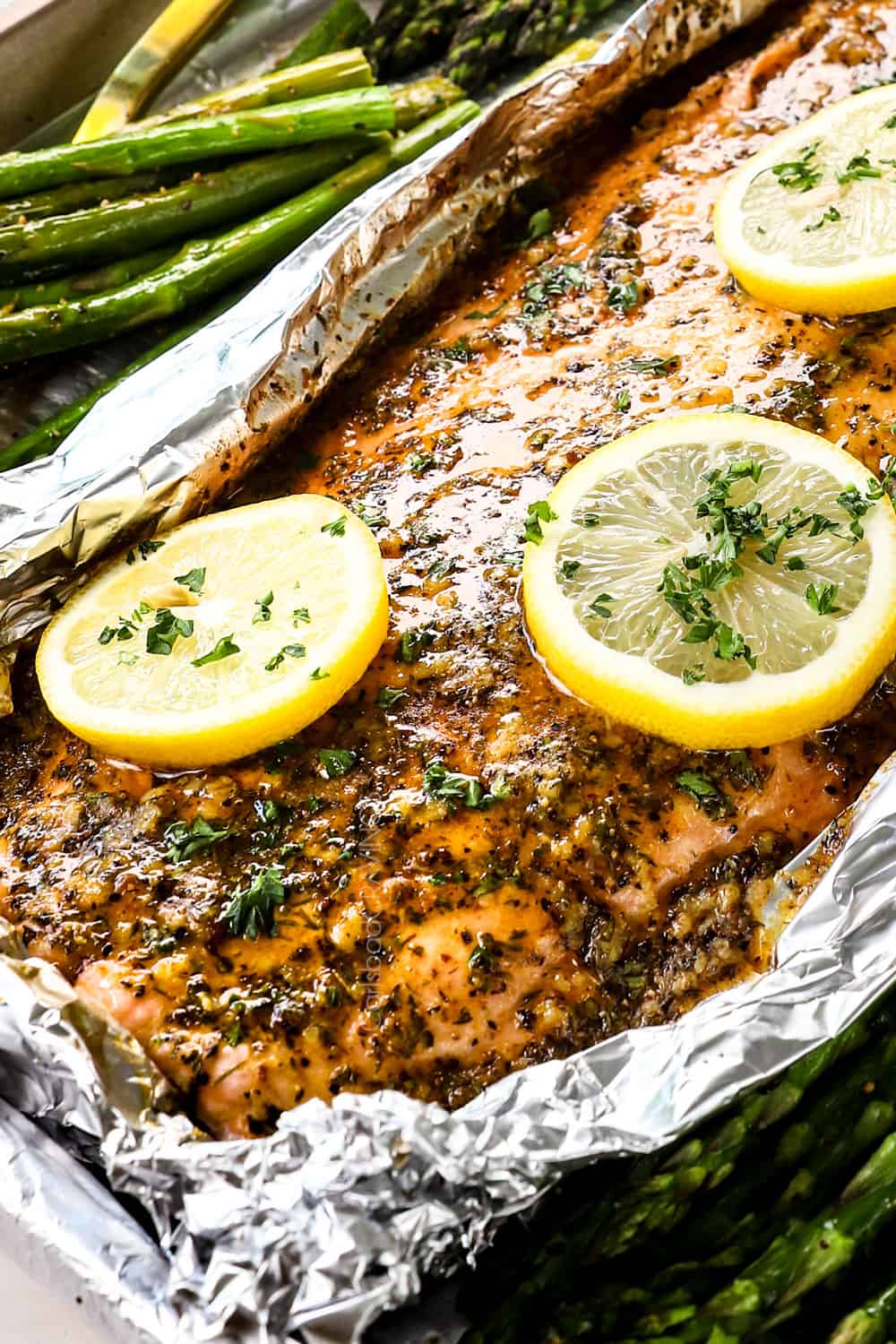
Can I make this Lemon Pepper Salmon on the grill?
Yes, this recipe is easy to cook on the grill! Completely enclose the salmon in foil (including the top) and preheat the grill to 375-400 degrees F with the lid closed. Add the salmon, close the grill and cook for 15-20 minutes depending on thickness, or until the salmon registers 130-135 degrees on an instant read thermometer inserted into the thickest part. (1-inch-thick salmon can take as little as 10 minutes, 1 ½-inch thick salmon will take closer to 20 minutes.)
POSSIBLE RECIPE VARIATIONS
- Increase lemon pepper: Use up to 2 tablespoons lemon pepper to really get a punch of flavor. You can also decrease the lemon pepper for a milder flavor.
- Add fresh herbs: Replace any of the dried herbs with three times the amount of fresh.
- Play with the seasoning: Mix up the herbs or the ratios to change the flavor profile.
- Make it spicy: Add additional pepper, red pepper or cayenne pepper.
- Swap the asparagus: Choose vegetables with similar cooking times such as broccoli, zucchini, bell peppers, green beans, etc., or mix and match veggies.
- Make it sweeter: Go for a honey lemon profile by adding 1-2 tablespoons honey to the lemon butter.
- Make it less tangy: Decrease the lemon juice or lemon pepper seasoning.
CAN I PREP THIS RECIPE IN ADVANCE?
Absolutely! Whisk all of the lemon pepper butter ingredients together and refrigerate. Line the salmon on a baking sheet with the asparagus and cover with foil. When ready to bake, microwave the lemon butter for 15 seconds or so to soften then slather it over the salmon. Let the salmon rest on the counter for 30 minutes, then proceed to bake per recipe instructions.
HOW LONG DOES COOKED SALMON LAST IN THE FRIDGE?
Store leftover salmon in an airtight container in the fridge for up to three days.
CAn I freeze baked salmon?
Freeze leftover salmon for up to 3 months. To freeze, slice salmon into fillets and place fillets in a freezer size bag in a single layer, squeeze out excess air to preserve freezer burn, label and freeze. You can also freeze individual salmon fillets by wrapping in plastic wrap before storing together. I do not recommend freezing the asparagus because it will become mushy once frozen and thawed.
HOW TO REHEAT BAKED SALMON
- From the fridge: Cut the salmon into fillets and gently reheat in a skillet, covered, for about 5 minutes or in the microwave at 30-second intervals. You can also warm in the oven for about 10 minutes at 275 degrees F, until it reaches an internal temperature of 125°F to 130°F. Take care not to overcook the salmon or it will become dry.
- From frozen: Thaw salmon in the refrigerator overnight then reheat per any of the above methods.
WHAT SIDES SHOULD I SERVE WITH OVEN BAKED SALMON?
This baked salmon recipe can be a meal-in-one with the salmon and asparagus, or it would also be delicious with:
- Grains: This vibrant lemony salmon loves a starch such as fancier rice pilaf, Parmesan risotto or mushroom risotto or simpler rice, quinoa, or low carb cauliflower rice or broccoli rice.
- Potatoes: Instead of rice, pair the baked salmon with mashed potatoes, melting potatoes, Hasselback potatoes, twice baked potatoes, smashed potatoes or mashed sweet potatoes.
- Salads: This robust, flavorful salmon pairs well with big refreshing salad such as watermelon feta salad, broccoli bacon salad, green bean salad, apple salad or strawberry spinach salad.
- Fruit: Sweet, refreshing fruit is always a welcome addition to balance the tangy lemon pepper seasoning. Try summer fruit salad, perfect fruit salad, creamy grape salad or tropical fruit salad.
- Bread: This sunshine recipe pairs beautifully with my favorite Garlic Bread, Moist Sweet Cornbread, Dinner Rolls or Parmesan Breadsticks.
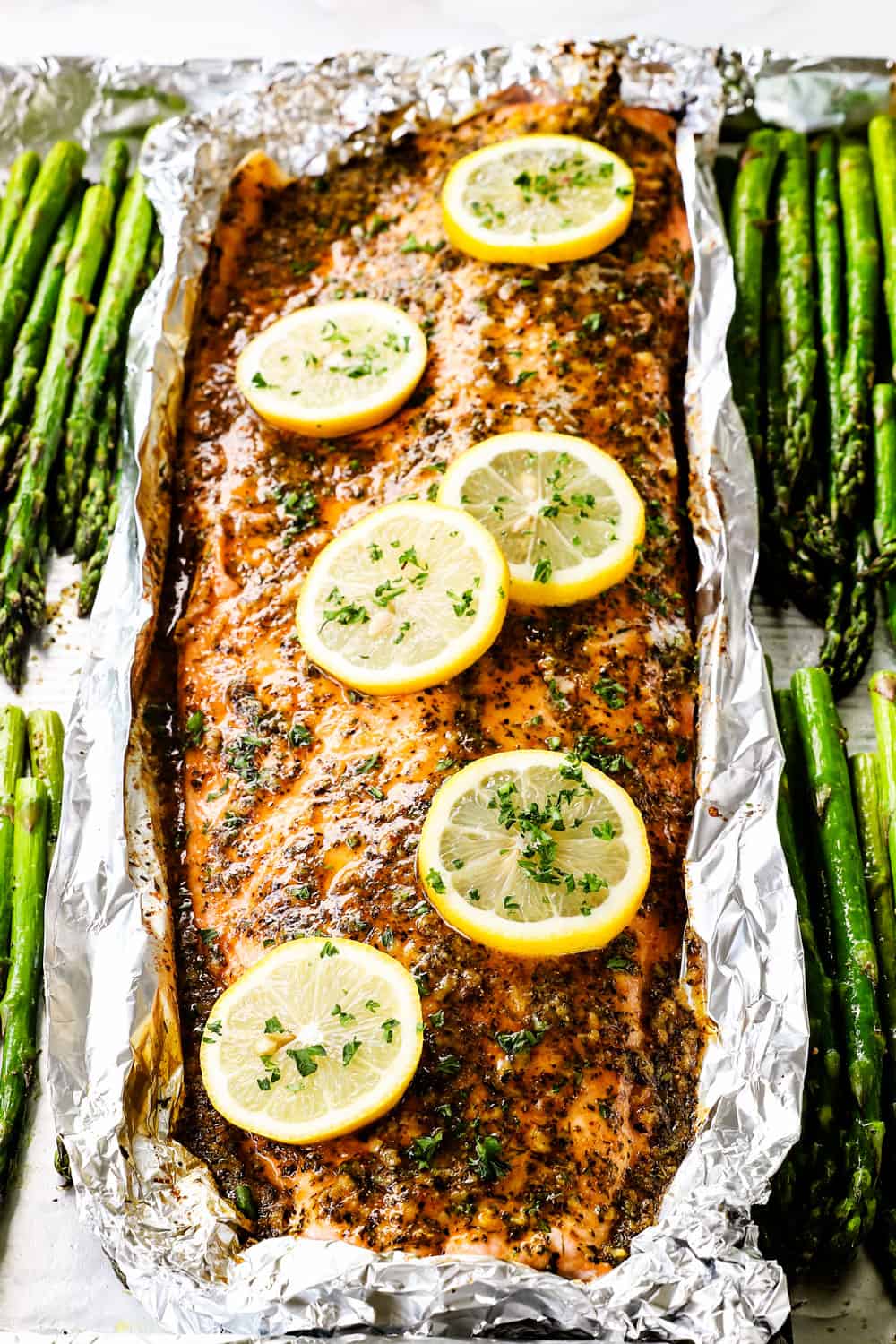
What can I make with leftovers?
This Lemon Pepper Salmon recipe makes fantastic leftovers! Add it to any of the below dishes to add a punch of flavor:
- Salmon salad: I LOVE adding salmon leftovers to salad. Add salmon to a bed of baby arugula, spring mix or spinach along with cucumbers, Craisins, feta, sliced almonds and sunflower seeds. If you’re feeling fancy, you can splurge with caramelized pecans (so good). Drizzle with olive oil and balsamic vinegar or I love mine with peach vinegar (you don’t even need to add oil!).
- Breakfast foods: Add flaked salmon to quiche, frittata, eggs benedict, or scrambled eggs or serve on the side of any type of eggs – so good!
- Salmon pasta: Add salmon to any of your favorite pastas such as fettuccine Alfredo, sun-dried tomato fettuccine, cacio e pepe, or creamy mushroom pasta. You can also go low carb and serve it with zoodles or spaghetti squash.
- Salmon risotto: Stir salmon into any of your favorite risotto recipes: mushroom risotto, Parmesan risotto, spinach risotto, butternut squash risotto – yum!
- Salmon grain bowls: Add your favorite grains to a bowl and pile with salmon and your favorite veggies. The veggies can be roasted/cooked like roasted broccoli, cauliflower, Brussels sprouts or butternut squash, or raw such as fresh tomatoes, thinly sliced radishes, sprouts etc. or pickled like pickled jalapenos, carrots, etc. or a combo of all three! You can also top with a fried or soft-boiled egg.
Lemon pepper salmon faqs
Salmon is be a low-calorie protein source that is rich in heart-healthy omega-3s, and low in saturated fat. It is also an excellent source of several B vitamins, antioxidants and potassium. Studies show that salmon can help lower inflammation, which may reduce the risk factors for several diseases and may help skin retain moisture. A growing number of studies also suggest that including salmon in your diet might improve brain function and even reduce symptoms of anxiety, depression and the risk of age-related memory problems. All great reasons to eat more salmon this year!
Bake salmon in the oven for 12-16 minutes at 400 degrees F. Baking times can vary based on the type of salmon, its thickness, and how done you like your salmon. For example, wild caught salmon such as coho and sockeye, tend to be thinner than king salmon and farm raised salmon so they will require less baking time. King salmon and farm raised salmon also tend to be fattier, so they are more forgiving if overbaked.
Due to these variables, I suggest using an instant read thermometer to know exactly when your salmon is done. A thermometer will ensure you buttery, juicy, succulent baked salmon every time. This is the exact one I use.
Yes, you can use fresh or frozen salmon for this baked Lemon Pepper Salmon recipe. If your salmon is frozen, thaw overnight in the refrigerator or thaw by placing the fillets (still in the plastic package) in a large bowl of cold water and replacing the water very 15 minutes or so until completely thawed.
The best temperature to bake salmon at is between 400ºF. This hotter temperature quickly cooks the salmon before it has time to dry out.
You can cook this recipe in the skillet instead of the oven. The salmon needs to cook for approximately 7 to 9 minutes, flipping halfway through.
LOOKING FOR MORE SALMON RECIPES?
- Grilled Chili Lime Salmon
- Honey Garlic Salmon
- Creamy Tuscan Salmon
- Creamy Salmon Pasta
- Asian BBQ salmon
- Blackened Salmon in Creamy Cajun Sauce
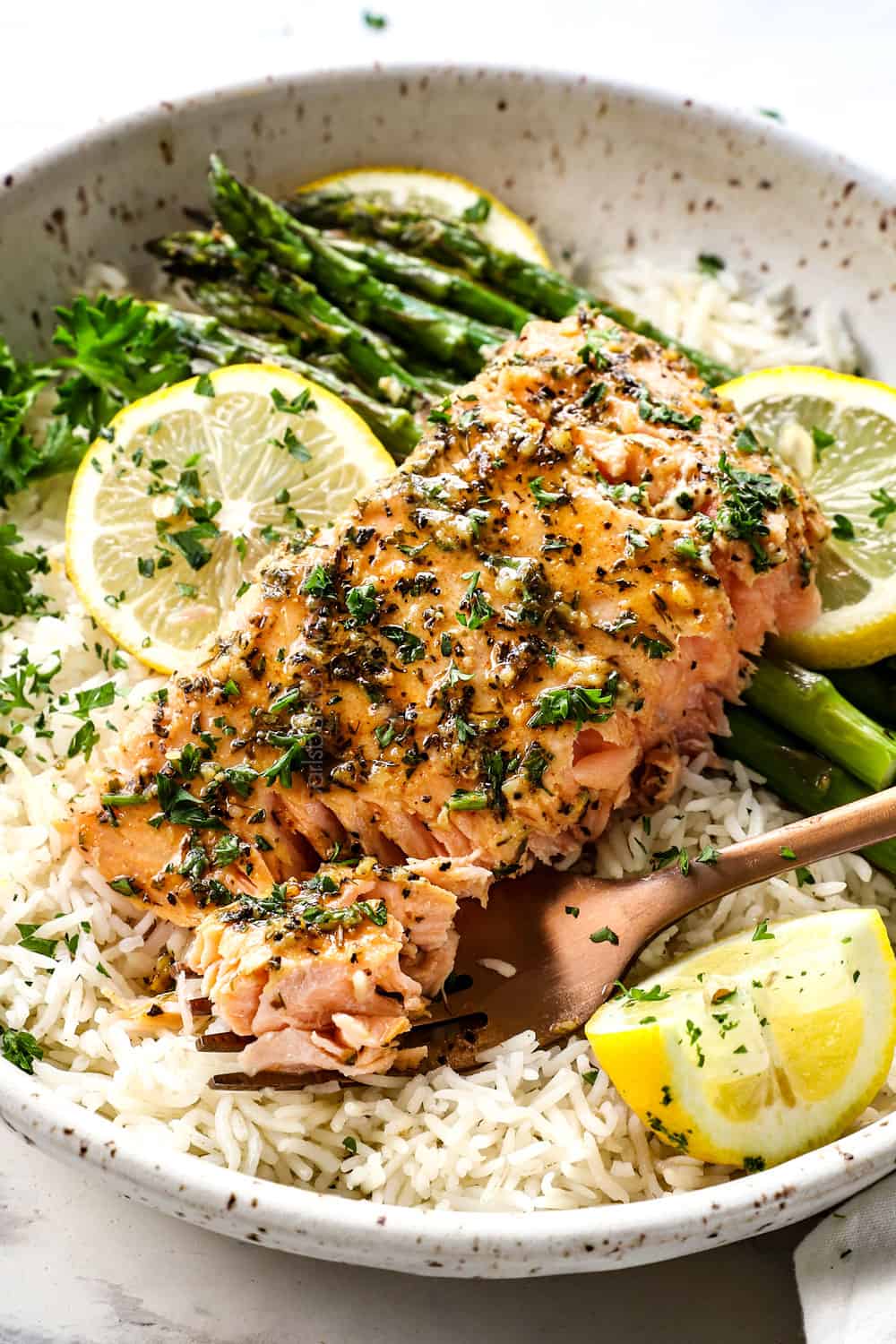
WANT TO TRY THIS baked lemon pepper SALMON RECIPE?
PIN IT TO YOUR DINNER, SALMON OR 30 minute meals BOARD TO SAVE FOR LATER!
FIND ME ON PINTEREST FOR MORE GREAT RECIPES! I AM ALWAYS PINNING :)!
©Carlsbad Cravings by CarlsbadCravings.com
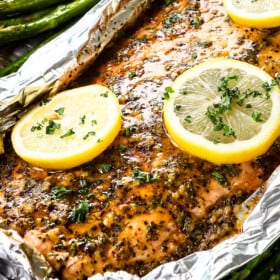
Lemon Pepper Salmon
Save This Recipe To Your Recipe Box
You can now create an account on our site and save your favorite recipes all in one place!
Ingredients
SALMON AND ASPARAGUS
LEMON PEPPER GARLIC BUTTER
- 4 tablespoons unsalted butter, melted (may sub half olive oil)
- 4-6 garlic cloves, minced
- 2 tablespoons lemon juice
- 1 1/2 tablespoons lemon pepper seasoning
- 1 ½ teaspoons Dijon mustard
- 1 tablespoon chopped fresh parsley (or 1 teaspoon dried)
- 1 tsp EACH dried thyme, dried basil, paprika
- 1/2 tsp EACH dried dill, onion powder, salt
Instructions
- Preheat oven to 400 degrees F.
- Line a baking sheet with foil for easy cleanup. Add asparagus to the baking sheet and drizzle with 1 ½ tablespoons olive oil and sprinkle with 1 ½ teaspoons lemon pepper and ¼ teaspoon salt. Toss to coat then push to the sides of the pan to make room for the salmon down the middle (the asparagus will be overlapping which is okay).
- Place a long piece of foil in between the asparagus. Spray with cooking spray then add salmon skin side down (if it has it) and fold foil up around the sides of the salmon to create a boat (don’t cover); set aside.
- Add the butter and minced garlic cloves to a medium bowl and microwave until butter is melted. Whisk in all remaining Lemon Pepper Butter ingredients. Pour evenly all over salmon.
- Bake for 12-16 minutes or until salmon is almost opaque throughout (internal temp of 125-130 degrees F at the thickest part) and easily flakes with a fork. Let rest 5 mintues before slicing. Garnish with fresh parsley if desired and season with freshly cracked salt and pepper to taste (I like more pepper) – always taste first!
Video
Notes
Tips and Tricks
- *Salmon fillets: You can also use six or seven 6-8 oz. salmon fillets. Frozen fillets are a great option because they are packaged at peak freshens. Thaw before using.
- Slice salmon if needed to fit: If your salmon fillet won’t fit on the pan, slice it into 2-inch pieces then line the pieces next to each other in rows within the foil “boat.” You can place all of the salmon at the top of the pan and the asparagus at the bottom if that fits better.
- Let salmon come to room temperature: Salmon should never be baked cold straight from the refrigerator otherwise it will cook unevenly. Place the salmon on the counter 30 minutes before you’re ready to bake it. You can slather it in the lemon pepper butter during this time.
- Use a meat thermometer: Overcooked salmon is dry salmon. The only way to ensure perfectly cooked salmon is to use a meat thermometer. You can pick up an inexpensive instant read thermometer at the grocery store or Amazon, or I am obsessed with this digital probe thermometer – you will never overcook any protein again!
- Prep ahead: Whisk all of the lemon pepper butter ingredients together and refrigerate. Line the salmon on a baking sheet with the asparagus and cover with foil. When ready to bake, microwave the lemon butter for 15 seconds or so to soften then slather it over the salmon. Let the salmon rest on the counter for 30 minutes, then proceed to bake per recipe instructions.
- Leftovers: See post for tons of leftover ideas!
How to store and reheat
- To store: Store leftover salmon in an airtight container in the fridge for up to three days.
- To freeze: Freeze leftover salmon for up to 3 months. To freeze, slice salmon into fillets and place fillets in a freezer size bag in a single layer, squeeze out excess air to preserve freezer burn, label and freeze. You can also freeze individual salmon fillets by wrapping in plastic wrap before storing together. Thaw salmon in the refrigerator overnight then reheat per instructions below. I do not recommend freezing the asparagus because it will become mushy once frozen and thawed.
- To reheat from the fridge: Cut the salmon into fillets and gently reheat in a skillet, covered, for about 5 minutes or in the microwave at 30-second intervals. You can also warm in the oven for about 10 minutes at 275 degrees F, until it reaches an internal temperature of 125°F to 130°F. Take care not to overcook the salmon or it will become dry.

Did You Make This Recipe?
Tag @CarlsbadCravings and Use #CarlsbadCravngs
Leave a Review, I Always Love Hearing From You!
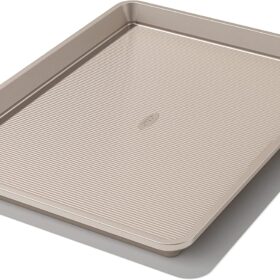
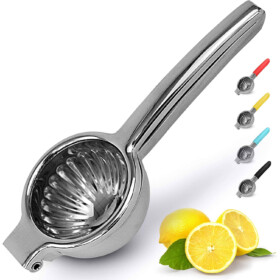

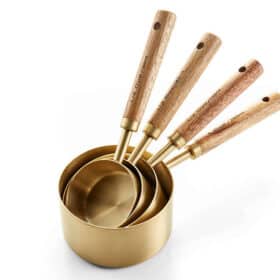
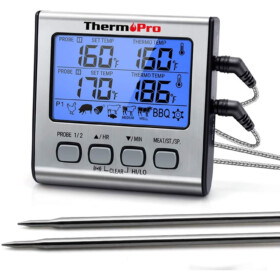
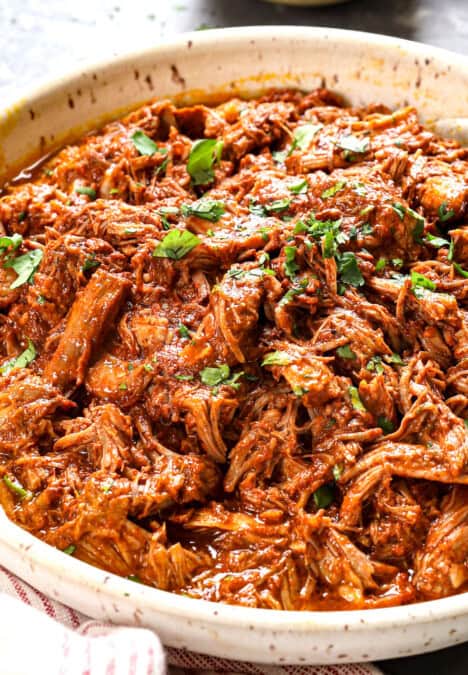
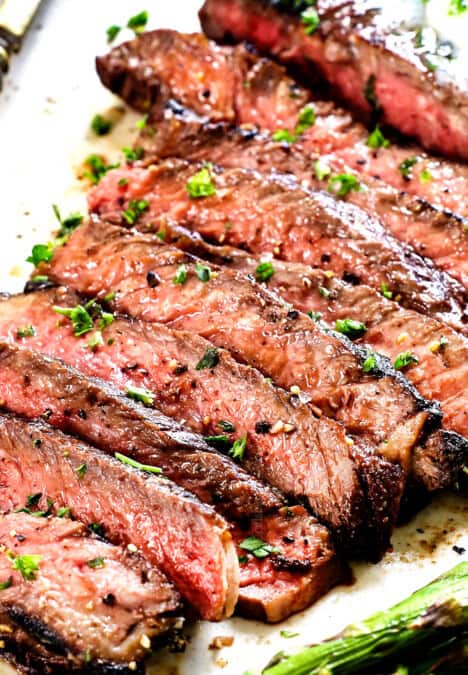
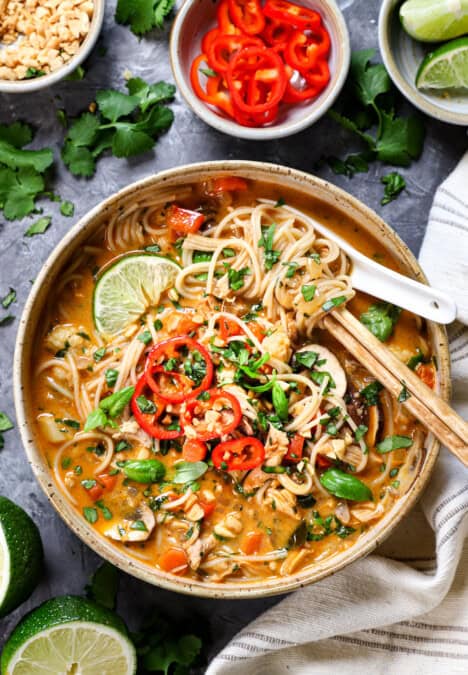
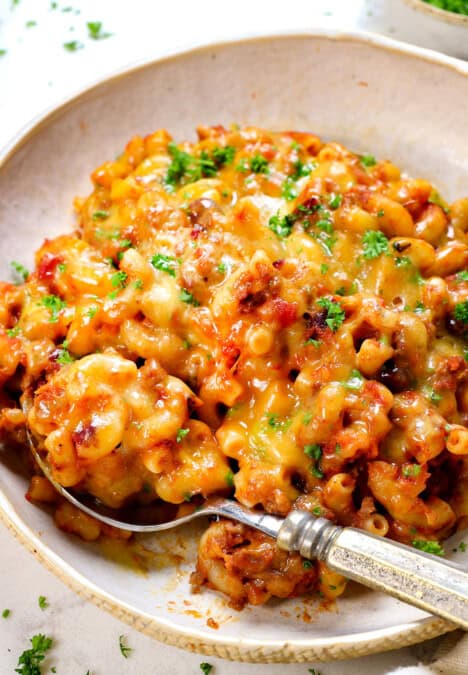
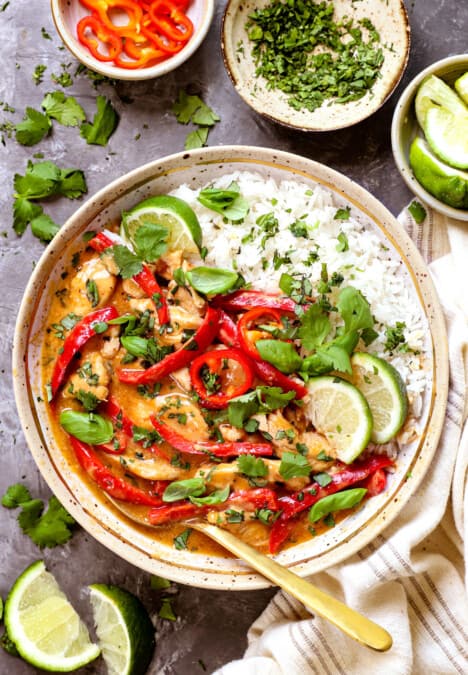
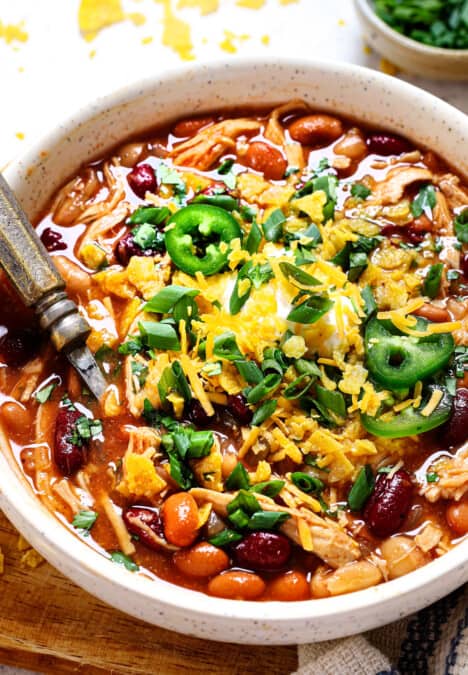























Najia Omer says
This turned out absolutely perfect! Full of flavour and easy to make, well explained. Made for family dinner and it received high praises from people who don’t normally even like salmon!
Jen says
Yay! Thank you so much, Najia! I am so happy it was such a hit!
Dorice says
Made this for Easter, large group of 20 from 14 years to 93 years of age…..it was a hit with everyone …even those that don’t ‘like’ fish. Also followed the recipe (rare for me) another great dish delivered from Carlsbad Cravings….have been following and making your recipes for years. Your work is great thank you for keeping our tummies happy!
Jen says
I’m glad it was a hit with even those who were unsure about fish! Thank you for your review, it means so much to me that you follow and try so many recipes!